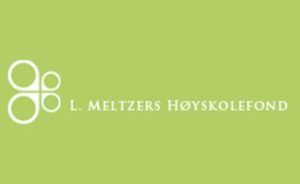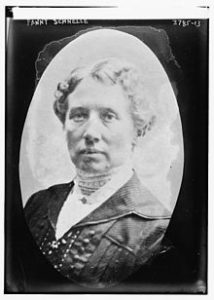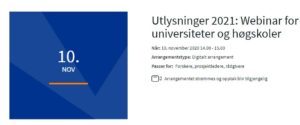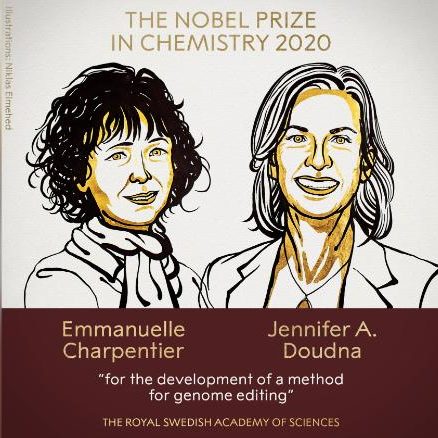(TCLS= Thursday Chemistry Lunch Seminar: 12.15-13 @ Tripletten
For ALL employees at the Chemistry Department!
Det er nå åpnet opp for at man kan søke L. Meltzers høyskolefond om inntil kr. 50 000,- i smådriftsmidler innenfor rammen av støtte til vitenskapelige reiser og aktivitet ved UiB.
Innenfor denne rammen kan man også søke om støtte til å delta på konferanser og seminarer, besøke partnerinstitusjoner, dra på feltarbeid ol.
Oppgaver/aktiviteter som møteledelse, chair, key note speaker, presentasjon av faglig arbeid (paper/poster) prioriteres.
Som før, kan man også søke til Meltzerfondet om:
Søknadsfrist 1. desember 2020.
Alle søknader skal sendes i UiBs søknadssystem for fond og legater: https://fond.app.uib.no/
Det er mulig å søke til Fanny Schnelles forskningsfond for kjemisk forskning. Fondet har som formål å fremme Kjemisk forskning

Fanny Schnelle anno 1915. Foto: https://en.wikipedia.org/wiki/Fanny_Schnelle
ved Universitetet i Bergen. Det bevilges i stor grad midler til utstyr for kjemisk forskning.
Man søker i søknadsportalen for Fond og legater ved UiB.
- Velg Det matematisk-naturvitenskapelige fakultet.
- Ny søknad ->Tittel på søknad -> Fanny Schnelle -> Fortsett til menyen hvor man velger fondet.
Rapportering av 2020 publikasjoner

Tidsfrist for rapportering av vitenskapelige publikasjoner for 2020 i Cristin er 31. januar 2021.
Rapporteringen er avgrenset til vitenskapelige artikler/oversiktsartikler, vitenskapelige bøker og vitenskapelige kapitler.
Viktig å sjekke:
At alle vitenskapelige publikasjoner for 2020 er korrekt registrert.
At det er lastet opp en fagfellevurdert fulltekstversjon av alle registrerte artikler.
Posisjoneringsmidler (POS-midler) for UiB-forskere som ønsker å posisjonere seg mot en fremtidig EU-søknad

Foto/ill.: Colourbox
Ramme for søknadene: Inntil 75 000 NOK.
Søknaden sendes til instituttet.
Mal for POS-søknad finnes her.
OPPDATERT: SPIRE såkornsmidler mot Forskningsrådet og andre eksterne finansieringskilder, men ikke til Horisont 2020/Horisont Europa
Årets utlysning er revidert som følge av koronapandemien.
Man kan nå søke støtte til:
• Frikjøp av forskere som jobber med søknader til NFR, Nordforsk og andre eksterne finansieringskilder (men ikke til Horisont Europa).
• Frikjøp av interne og/eller eksterne postdocs og vitenskapelige assistenter som hjelper UiB-forskere med søknadsskriving.
Merk: All frikjøp må først avklares og støttes av instituttleder før det kan søkes om støtte til dette formålet.
• Bruk av eksterne konsulenter som UiB har avtale med.
• Støtte videre arbeid med SFF-søknader fra januar – april 2021.
Utlysning knyttet til gjesteforskere er også endret slik at man nå kan søke om opphold inntil 6 mnd.
Søknaden sendes til instituttet.
Mal for SPIRE-søknad finnes her.

Webinar rettet mot neste års utlysninger – les mer om hva det inneholder her.
Webinaret strømmes og lenken ligger på Forskningsrådets nettside.

Det er nå åpent for søknader til L. Meltzers høyskolefond.
Det kan søkes om: 
- Støtte til forskningstermin, maksimalt NOK 150 000,-.
- Reisestipend til vitenskapelige reiser, maksimalt NOK 50 000,-.
- Prosjektstipend for studenter og stipendiater.
Søknadsdatabasen er åpen.
Søknadsfrist 1. desember 2020.
Alle søknader til Meltzerfondet skal leveres på https://fond.app.uib.no/
Charlotte Langeland Nakken er ansatt som 4-årig PhD kandidat i analytisk kjemi fra 1. september i år. Hun skal arbeide med metodeutvikling (Vion IMS QTof) for identifisering av metabolitter fra oljekomponenter og DNA-addukter i marin fisk. Et av hovedmålene er å identifisere forurensningskildene som er ansvarlig for DNA-skade i villfisk fanget rundt oljeplattformene i Nordsjøen. Veiledere er Svein Mjøs på Kjemisk, og Carey Donald og Sonnich Meier ved Havforskningsinstituttet (HI).

Arbeidet blir utført ved forskningsgruppen Marin toksikologi ved HI. Charlotte har master i miljøkjemi/analytisk kjemi fra UiB, og masterprosjektet ble utført ved HI og omhandlet å finne effekter av og tålegrenser for oljeforurensning hos fiskeegg.
Dr. Tamal Roy has joined as a postdoc (3 years) in the Le Roux group. He will be working on developing radiotracers based on 45Ti for PET imaging in collaboration with the Bergen Tracer Development Centre (Bergen-TDC) financed by the Trond Mohn foundation. The goal of the project is to develop suitable water soluble and hydrothermally stable 45Ti complexes.
Tamal did his PhD from CSIR-CSMCRI, India in 2014 in the area of synthesis of chiral epoxides and their derivatives. Later he spent several years in Sweden (KTH, Uppsala) and Denmark (Copenhagen) as a postdoctoral researcher. His research experiences include asymmetric catalysis, method developments, organometallic chemistry, medicinal chemistry and development of PET tracers for β cell imaging.
 Gender inequality is a topical issue in science. The movie Picture a scientist, appearing on the BIFF program for Saturday and Monday, makes a powerful and insightful presentation of how this affects the career of individuals. IMDb-rating of 8.2 / 10. UiB employees may purchase tickets at a reduced rate, at only 55 NOK. On the Monday show, our colleague at the Dept of Biosciences, Dr. Dorothy Dankel, introduces the movie and puts it into a wider context. Recommended!
Gender inequality is a topical issue in science. The movie Picture a scientist, appearing on the BIFF program for Saturday and Monday, makes a powerful and insightful presentation of how this affects the career of individuals. IMDb-rating of 8.2 / 10. UiB employees may purchase tickets at a reduced rate, at only 55 NOK. On the Monday show, our colleague at the Dept of Biosciences, Dr. Dorothy Dankel, introduces the movie and puts it into a wider context. Recommended!
The Royal Swedish Academy of Sciences has awarded the Nobel Prize in Chemistry for 2020 to Emmanuelle Charpentier (Director of the Max Planck Unit for the Science of Pathogens, Berlin) and Jennifer A. Doudna (Professor at the University of California, Berkeley) “for the development of a method for genome editing.” The method in question is CRISPR/Cas9, the importance of which can hardly be overestimated. 
Prior to 2020, 183 individuals had been awarded the Nobel prize in chemistry (counting Frederick Sanger once despite him being awarded twice). There were only five female laureates: Maria Skłodowska-Curie, Irène Joliot-Curie (1935), Dorothy Hodgkin (1964), Ada Yonath (2009) and Frances Arnold (2018). Approaching the end of a year where the chemical societies have seen the need to stress the importance of equality in the chemical sciences and work places, it is well worth drawing attention to the fact that this year’s Nobel prize is split between two eminent female scientists (both of whom are younger than the writer of this column).






 Arbeidet blir utført ved forskningsgruppen Marin toksikologi ved HI. Charlotte har master i miljøkjemi/analytisk kjemi fra UiB, og masterprosjektet ble utført ved HI og omhandlet å finne effekter av og tålegrenser for oljeforurensning hos fiskeegg.
Arbeidet blir utført ved forskningsgruppen Marin toksikologi ved HI. Charlotte har master i miljøkjemi/analytisk kjemi fra UiB, og masterprosjektet ble utført ved HI og omhandlet å finne effekter av og tålegrenser for oljeforurensning hos fiskeegg.
 Gender inequality is a topical issue in science. The movie Picture a scientist, appearing on the
Gender inequality is a topical issue in science. The movie Picture a scientist, appearing on the 